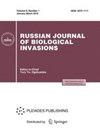THE FIRST RECORD OF CEPAEA NEMORALIS (LINNAEUS, 1758) (MOLLUSCA: GASTROPODA: HELICIDAE) IN THE DONBASS AND THE PHENETIC STRUCTURE OF THE FOUND COLONY
IF 0.6
Q4 ECOLOGY
引用次数: 0
Abstract
The phenetic composition of Cepaea nemoralis (Linnaeus, 1758) (Mollusca: Gastropoda: Helicidae) colony found in an area of continuous high-rise buildings in the center of Donetsk in 2022 is described. The area of the colony is 2.5 ha, the number reaches 15 ind./m2, the age is at least 10 years. Individuals with a pink ground colours (81.5%) and one central band in 64.7% of yellow-coloured and 76.8% of pink-coloured shells are clearly dominated. The absence of unbanded shells and shells with reduced 1, 2, 4 and 5 bands was a distinctive feature of the Donetsk colony. The trend of dominance of phenotypes with fused bands is traced for five-banded shells with the relative frequency of 69.7%. Morphs with fusion types of bands, namely F(45) - 13.2% and F(23) - 12.8% dominate. The colony is characterized by a relatively high degree of polymorphism (𝜇 = 4.78±0.039) and proportion of rare morphs (h±𝑆ℎ = 0.47±0.026) showing no similarities with the colonies in Eastern Europe available for meta-analysis. Cepaea nemoralis is likely to remain one of the elements in the urban fauna, not showing any tendency to expand into natural ecosystems.在顿巴斯发现的第一例麻蝇(linnaeus, 1758)(软体动物:腹足目:螺旋虫科)及其菌落的遗传结构
描述了2022年在顿涅茨克市中心连续高层建筑区域发现的nemoralis (Linnaeus, 1758)(软体动物:腹足目:螺螺虫科)群落的遗传组成。蜂群面积2.5 ha,数量达到15只/m2,年龄在10年以上。在64.7%的黄色外壳和76.8%的粉红色外壳中,粉红色底色(81.5%)和一个中心带的个体明显占主导地位。没有无带炮弹和1、2、4和5带减少的炮弹是顿涅茨克殖民地的一个显著特征。在五条带壳中,融合带显性表型的相对频率为69.7%。以F(45) - 13.2%和F(23) - 12.8%的熔合带形态为主。该群体具有较高的多态性程度(≥4.78±0.039),稀有变种比例(h±𝑆 ̄= 0.47±0.026),与东欧地区的群体没有相似之处。沙蚕很可能仍然是城市动物群的一个组成部分,没有任何扩展到自然生态系统的趋势。
本文章由计算机程序翻译,如有差异,请以英文原文为准。
求助全文
约1分钟内获得全文
求助全文
来源期刊
CiteScore
1.20
自引率
14.30%
发文量
40
期刊介绍:
Russian Journal of Biological Invasions publishes original scientific papers dealing with biological invasions of alien species in both terrestrial and aquatic ecosystems and covers the following subjects:description of invasion process (theory, modeling, results of observations and experiments): invasion corridors, invasion vectors, invader species adaptations, vulnerability of aboriginal ecosystems;monitoring of invasion process (reports about findings of organisms out of the limits of natural range, propagule pressure assessment, settling dynamics, rates of naturalization);invasion risk assessment; genetic, evolutional, and ecological consequences of biological invasions of alien species; methods, means of hoarding, processing and presentation of applied research data (new developments, modeling, research results, databases) with factual and geoinformation system applications;use of the results of biological invasion research (methods and new basic results) under the study of marine, fresh-water and terrestrial species, populations, communities and ecosystems; control, rational use and eradication of the harmful alien species..

 求助内容:
求助内容: 应助结果提醒方式:
应助结果提醒方式:


